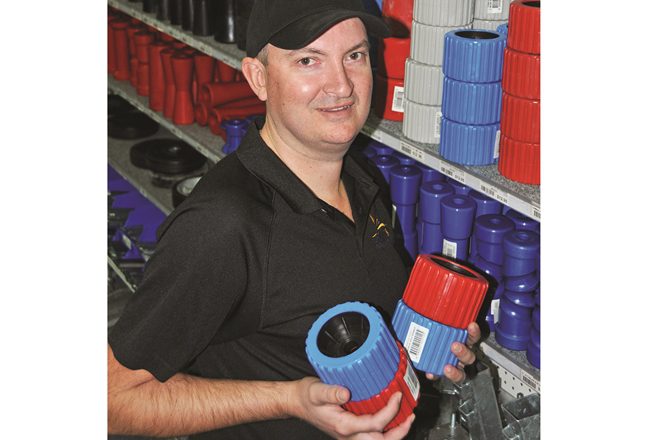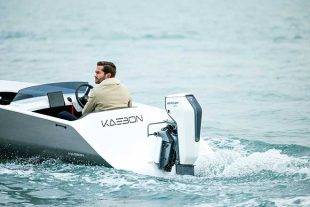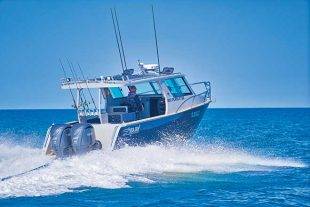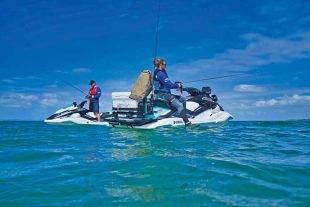LEADING marine products retailer Boating and RV, which has stores at Capalaba, Slacks Creek, Tingalpa and Townsville, has joined with Bush ‘n Beach to bring you a regular column with some serious information and news about general boating products. Here, director Aaron Hunt looks at boat trailer rollers – which ones for what purpose.
Fancy having a tonne of weight on your back, then being covered in dirt and brake dust before being dumped into cold water, then hauled out and left to bake in the sun all day?
Well that’s the life of the rollers on your boat trailer. No wonder they crack up – literally. It’s a rough life and sometimes short, but you can make it longer. There is some blurring of the lines, or rather, the colours between different rollers as more options have become available.
But if we consider the traditional view, there are black, red and blue trailer rollers (we’ll get to some of the other colours later). Black is generally a rubber roller – an economy model often found under ‘economy’ boats. Blue rollers are high-density polyethylene. They are a much harder roller and therefore ideal to go under the keel of aluminium and plate alloy boats.
Red rollers are frequently made from polyurethane, which makes them a softer roller and you’ll typically find them under fibreglass boats. And then there’s grey, which can be virtually anything, and clear-yellow rollers that are often radically scalloped and used to square the bow into position. But rollers have different shapes (or profiles) and they have different functions as well.
You might for example find the first roller on your trailer has a spiral rib, which helps the boat centre itself coming onto the trailer. But for it to work effectively, the boat needs a sharp forefoot that will track accurately. It would probably be pointless on a flat-bow punt where contact might only be made on the outer edges of the roller.
Sometimes the lead roller might be coupled to a loading mechanism such as an Ezi-Guide, which will steer both sides of the forefoot straight up the trailer. Others might use a low-friction strip either side to allow the skipper to screw the vessel around to centre point should a crosswind or strong tidal run make lining it up difficult.
But the bottom line is the rollers need to be matched to your specific boat and have to be set up correctly. Wobble rollers, common on drive-on, drive-off trailers, come in a variety of styles – smooth or with faces patterned by ribs or chevrons as well as having different interior contact points – some are short for more ‘wobble’, while some are longer to carry more load. Other rollers are designed to provide a conveyor belt style of support.
You should check with the manufacturer of your trailer for their preferred setup, but you then need to think about it carefully. For an aluminium boat with an extruded keel, most of the weight is borne by a system of centre rollers with side supports (be they rollers, or perhaps more likely, skids), which are really just there to help keep the boat square on its keel and the trailer.
Other manufacturers, including some plate boat builders, prefer to have low-friction structural support ribs all along the sides of their vessels. They sometimes position the centre rollers just a fraction short of centreline contact.
That’s because they use the centre rollers to ‘cushion’ flex rather than bear the full load of transporting the vessel. The side ribs bear the weight and sometimes have a collective surface area far greater than a typical roller system in order to spread the load. Again, it depends on matching the support system exactly to your boat, particularly if you are going to be travelling on rough roads.
You should consult your trailer manufacturer and your boat manufacturer – not the selling dealership, but the manufacturer – if you have any doubts about the optimum setup. Having spoken with them, you’ll know what parts or replacement rollers you will need from a retail outlet such as Boating and RV.
But in the final analysis, the boat should just sit on the trailer on the ramp when it is at rest, once the winch wire has been released. Just the slightest push or just snicking the motor into reverse should be enough to glide it off the trailer.
Does that mean you should back down the boat ramp without the safety chain and winch wire attached? Absolutely not. Never, not ever.
It just means that at the moment you are ready for the boat to leave the trailer and everything is disconnected, it should just sit there requiring a smidge of oomph to begin its slide. Therefore, your rollers and the way they are set up should be able to hold it in that position. The spindle is the axle that goes through the roller.
Some people swear by adding some lubrication to the spindles, thinking it will reduce friction between the spindle and the hub of the roller. But in our experience, materials like lanolin, Vaseline and marine grease might offer some slight benefit in terms of providing some degree of protection for the spindle against rust, but this is more than offset by that very same material attracting every spec of grit, dirt and dust from every road travelled.
It doesn’t take too long before that builds up into a hard-caked abrasive gunk pile that wears away at the inside channel of the roller. In worst cases, the roller becomes a non-roller, which makes launching and retrieving your boat a proper pain. Clean the faces of your rollers every so often.
Detergent and a medium-stiffness bristle brush will do the job and fortunately, it is a relatively quick exercise. Clean roller faces will stop crud being ground into your hull. Cleaning the rollers also provides an opportunity for you to inspect them for wear, noting that replacement of rollers is a normal part of boat maintenance.
 Bush 'n Beach Fishing Magazine Location reports & tips for fishing, boating, camping, kayaking, 4WDing in Queensland and Northern NSW
Bush 'n Beach Fishing Magazine Location reports & tips for fishing, boating, camping, kayaking, 4WDing in Queensland and Northern NSW








